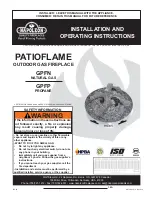
9
Burner Manual —
CG10-24
Section: INSPECT/PREPARE
INSTALLATION SITE
Examine the installation site for conditions that could
adversely affect the health and safety of installation
personnel and the user of the appliance or proper
operation of the burner and appliance, and correct any
defects found.
|
The area around the appliance should be
unobstructed and dry.
|
Wiring must be in good condition and meet state &
local code requirements.
|
If the burner is replacing an existing oil burner, old
piping and the tank must be secured or removed to
prevent leakage or unintended deliveries of oil.
|
Local jurisdictions may require removal of oil tanks.
See NFPA-30 flammable and combustible liquids
code for approved procedures.
Inspect Chimney and Vent System
1. Any accumulation of soot or debris in chimney
offsets must be removed
2. Any obstructions such as a protruding joint or a
piece of broken tile wedged in the chimney must
be removed.
3. No other appliance connection should be made to
the same flue pipe.
4. The flue pipe must have an upward pitch toward the
chimney of at least 1/4” per foot of length. It should
fit tightly and should not project into the chimney,
see
Explosion, Fire, and
Asphyxiation Hazard
Wet or dusty environments could lead
to blocked air passages, corrosion
damage to components, impaired
combustion performance.
•
This burner is designed for clean,
dry installations.
•
Electrical controls are not protected against rain
or sprayed liquids.
•
Keep the installation clear of dust, dirt, corrosive
vapors, and moisture.
•
Protective covers and frequent maintenance may
be required.
Inspect/Prepare
Installation Site
Indoor Installation
Barometric Draft Control
Flue Pipe Ell
Heating Unit
1/4” per Foot
Minimum
Figure 6 –
Vent Pipe with Draft Regulator
Fire, Smoke and
Asphyxiation Hazard
•
Carefully inspect the chimney, chimney
liner & exhaust vent system.
•
Make sure it is properly sized and in
good working condition.
•
Follow the instructions supplied by the
appliance manufacturer.
•
If a draft regulator is required, it must be
a double-acting type, agency recognized
for use with gas vent systems.
•
The chimney installation and vent
sizing must strictly comply with all
applicable codes, authorities having
jurisdiction and the latest revision of the
National Fuel Gas Code (ANSI Z223.1,
or NFPA54) or CAN/CGA B/49 Canada.
Remove any vent damper device.
•
Regulation by these authorities
take precedence over the general
instructions provided in this installation
manual.










































